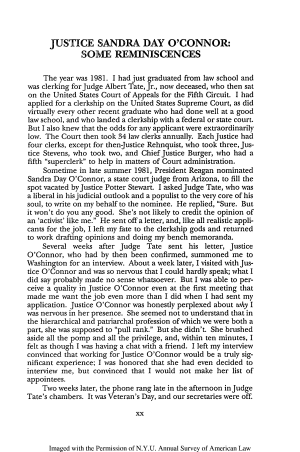Justice Sandra Day O’Connor: Some Reminiscences
January 1, 1996

Other pages in the O'Connor Institute Online Archive mentioned in this article:
| NAME / TITLE | TYPE |
|---|---|
| Gary L. Francione | Law Clerk |
Article Text
(Excerpt)
JUSTICE SANDRA DAY O'CONNOR: SOME REMINISCENCES
The year was 1981. I had just graduated from law school and was clerking for Judge Albert Tate, Jr., now deceased, who then sat on the United States Court of Appeals for the Fifth Circuit. I had applied for a clerkship on the United States Supreme Court, as did virtually every other recent graduate who had done well at a good law school, and who landed a clerkship with a federal or state court. But I also knew that the odds for any applicant were extraordinarily low. The Court then took 34 law clerks annually. Each Justice had four clerks, except for then-Justice Rehnquist, who took three, Justice Stevens, who took two, and Chief Justice Burger, who had a fifth "superclerk" to help in matters of Court administration. Sometime in late summer 1981, President Reagan nominated Sandra Day O'Connor, a state court judge from Arizona, to fill the spot vacated by Justice Potter Stewart. I asked Judge Tate, who was a liberal in his judicial outlook and a populist to the very core of his soul, to write on my behalf to the nominee. He replied, "Sure. But it won't do you any good. She's not likely to credit the opinion of an 'activist' like me." He sent off a letter, and, like all realistic applicants for the job, I left my fate to the clerkship gods and returned to work drafting opinions and doing my bench memoranda. Several weeks after Judge Tate sent his letter, Justice O'Connor, who had by then been confirmed, summoned me to Washington
